All the solutions provided in McGraw Hill My Math Kindergarten Answer Key PDF Chapter 5 Lesson 5 How Many in All? will give you a clear idea of the concepts.
McGraw-Hill My Math Kindergarten Answer Key Chapter 5 Lesson 5 How Many in All?
Explore and Explain
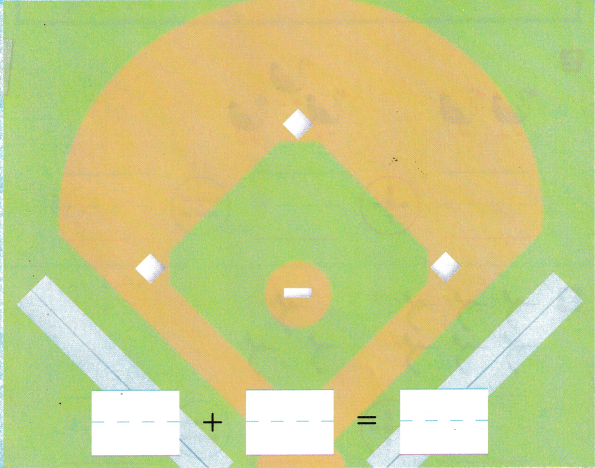
Teacher Directions: Use ![]() to model each group. There are four players on the field. Four more players come to play, Write the numbers. Write how many players there are in all.
to model each group. There are four players on the field. Four more players come to play, Write the numbers. Write how many players there are in all.
Answer: 4 + 4 = 8
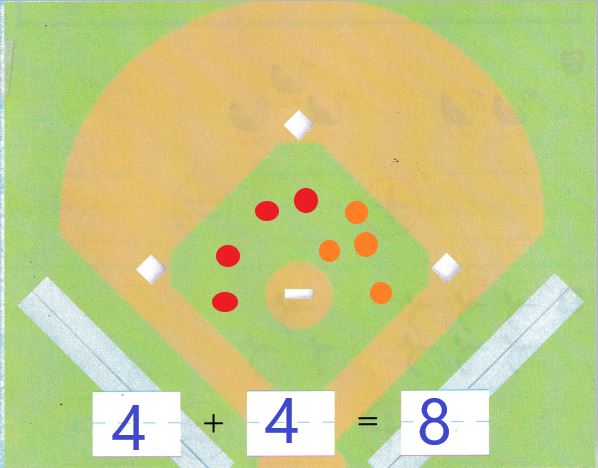
Number of players on the field = 4 (four)
Number of more players come to play = 4 (four)
Therefore, total number of players = 4 + 4 = 8 (eight)
The + in general called as addition symbol. This addition symbol is usually used to indicate that two or more numbers should be added together.
Combining things and counting them as one big group is done through addition. In math, addition is the process of adding two or more integers together. Addends are the numbers that are added, and the result or the final answer we get after the process is called the sum.
The = equals symbol is used to show that the values on either side of it are the same. It is most commonly used to show the result of a calculation.
See and Show
Question 1.
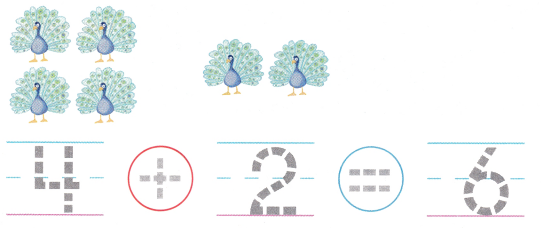
4 + 2 = 6
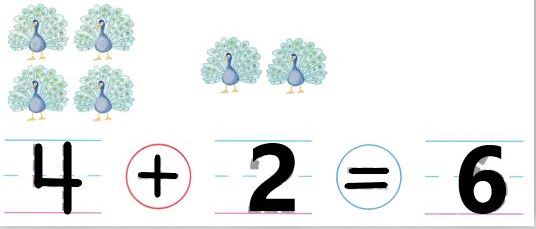
Number of peacocks in first group = 4
Number of peacocks in second group = 2
Therefore, total number of peacocks = 4 + 2 = 6
The + in general called as addition symbol. This addition symbol is usually used to indicate that two or more numbers should be added together.
Combining things and counting them as one big group is done through addition. In math, addition is the process of adding two or more integers together. Addends are the numbers that are added, and the result or the final answer we get after the process is called the sum.
The = equals symbol is used to show that the values on either side of it are the same. It is most commonly used to show the result of a calculation.
Question 2.
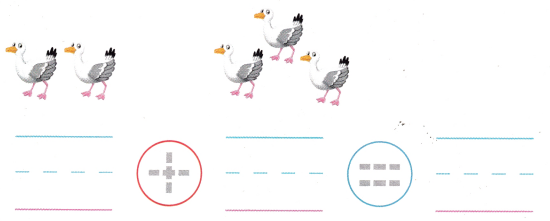
Answer: 2 + 3 = 5
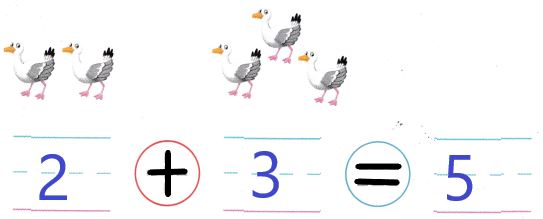
Number of ducks in first group = 2
Number of ducks in second group = 3
Therefore, total number of ducks =2 + 3 = 5
The + in general called as addition symbol. This addition symbol is usually used to indicate that two or more numbers should be added together.
Combining things and counting them as one big group is done through addition. In math, addition is the process of adding two or more integers together. Addends are the numbers that are added, and the result or the final answer we get after the process is called the sum.
The = equals symbol is used to show that the values on either side of it are the same. It is most commonly used to show the result of a calculation.
Question 3.

Answer: 6 + 3 = 9

Number of birds in first group = 6
Number of birds in second group = 3
Therefore, total number of birds =6 + 3 = 9
The + in general called as addition symbol. This addition symbol is usually used to indicate that two or more numbers should be added together.
Combining things and counting them as one big group is done through addition. In math, addition is the process of adding two or more integers together. Addends are the numbers that are added, and the result or the final answer we get after the process is called the sum.
The = equals symbol is used to show that the values on either side of it are the same. It is most commonly used to show the result of a calculation.
Directions: 1. Use counters to model the addition sentence. Trace the numbers and the symbols. Trace how many there are in all. 2-3. Use the counters to model the addition sentence. Write the numbers and trace the symbols. Write how many there are in all.
On My Own
Question 4.

Answer: 3 + 1 = 4
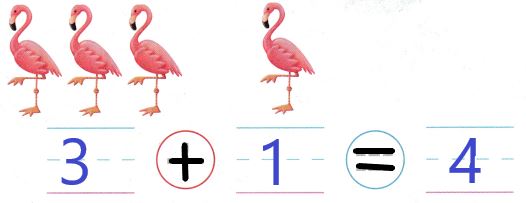
Number of flamingoes in first group = 3
Number of flamingoes in second group = 1
Therefore, total number of flamingoes =3 + 1 = 4
The + in general called as addition symbol. This addition symbol is usually used to indicate that two or more numbers should be added together.
Combining things and counting them as one big group is done through addition. In math, addition is the process of adding two or more integers together. Addends are the numbers that are added, and the result or the final answer we get after the process is called the sum.
The = equals symbol is used to show that the values on either side of it are the same. It is most commonly used to show the result of a calculation.
Question 5.
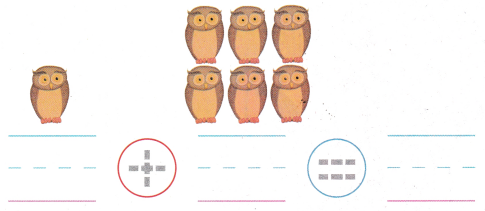
Answer: 1 + 6 = 7
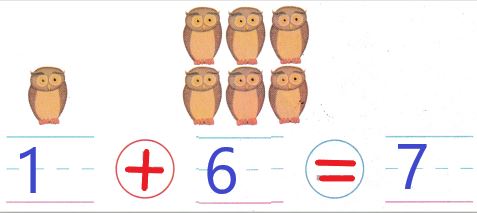
Number of owls in first group = 1
Number of owls in second group = 6
Therefore, total number owls =1 + 6 = 7
The + in general called as addition symbol. This addition symbol is usually used to indicate that two or more numbers should be added together.
Combining things and counting them as one big group is done through addition. In math, addition is the process of adding two or more integers together. Addends are the numbers that are added, and the result or the final answer we get after the process is called the sum.
The = equals symbol is used to show that the values on either side of it are the same. It is most commonly used to show the result of a calculation.
Question 6.
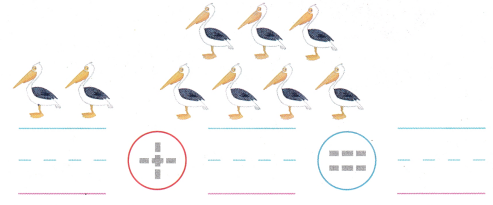
Answer: 2 + 7 = 9

Number of birds in first group = 2
Number of birds in second group = 7
Therefore, total number of birds = 2 + 7 = 9
The + in general called as addition symbol. This addition symbol is usually used to indicate that two or more numbers should be added together.
Combining things and counting them as one big group is done through addition. In math, addition is the process of adding two or more integers together. Addends are the numbers that are added, and the result or the final answer we get after the process is called the sum.
The = equals symbol is used to show that the values on either side of it are the same. It is most commonly used to show the result of a calculation.
Directions: 4-6. Use counters to model the addition sentence. Write the numbers and trace the symbols. Write how many there are in all.
Problem Solving
Question 7.
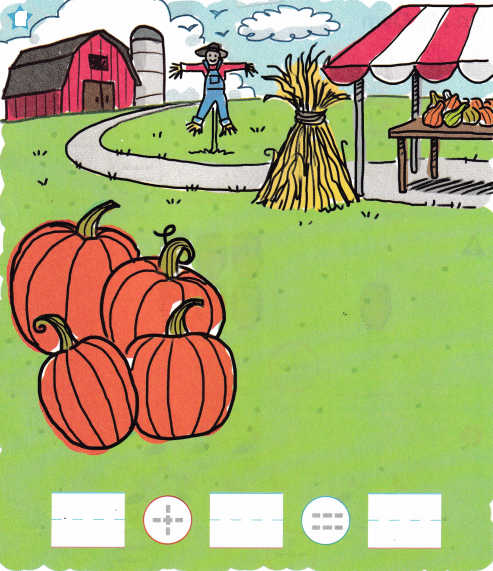
Answer: 4 + 4 = 8
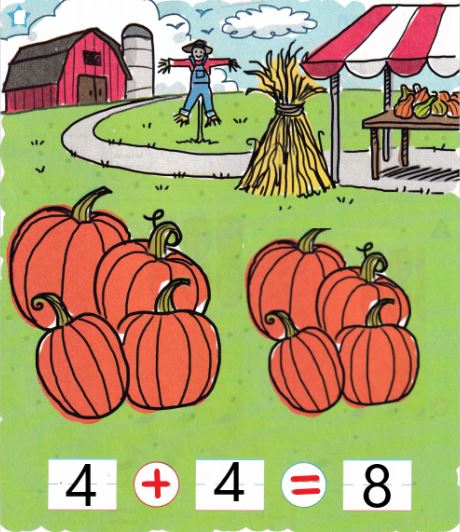
Number of pumpkins in first group = 4
Number of pumpkins in second group = 4
Therefore, total number of pumpkins = 4 + 4 = 8
The + in general called as addition symbol. This addition symbol is usually used to indicate that two or more numbers should be added together.
Combining things and counting them as one big group is done through addition. In math, addition is the process of adding two or more integers together. Addends are the numbers that are added, and the result or the final answer we get after the process is called the sum.
The = equals symbol is used to show that the values on either side of it are the same. It is most commonly used to show the result of a calculation.
Directions: 7. Count the pumpkins. Write the number on the line below the pumpkins. Trace the plus sign. Draw a group that has less than six pumpkins. Write the number. Trace the equals sign. Write how many pumpkins there are in all.
McGraw Hill My Math Kindergarten Chapter 5 Lesson 5 My Homework Answer Key
Question 1.
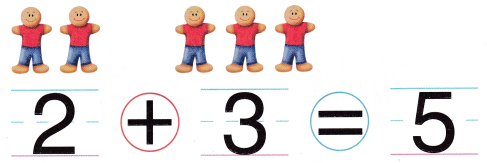
Number of objects in first group = 2
Number of objects in second group = 3
Therefore, total number of objects =2 + 3 = 5
The + in general called as addition symbol. This addition symbol is usually used to indicate that two or more numbers should be added together.
Combining things and counting them as one big group is done through addition. In math, addition is the process of adding two or more integers together. Addends are the numbers that are added, and the result or the final answer we get after the process is called the sum.
The = equals symbol is used to show that the values on either side of it are the same. It is most commonly used to show the result of a calculation.
Question 2.

Answer: 5 + 5 = 10

Number of objects in first group = 5
Number of objects in second group = 5
Therefore, total number of objects =5 + 5 = 10
The + in general called as addition symbol. This addition symbol is usually used to indicate that two or more numbers should be added together.
Combining things and counting them as one big group is done through addition. In math, addition is the process of adding two or more integers together. Addends are the numbers that are added, and the result or the final answer we get after the process is called the sum.
The = equals symbol is used to show that the values on either side of it are the same. It is most commonly used to show the result of a calculation.
Question 3.

Answer: 4 + 2 = 6

Number of objects in first group = 4
Number of objects in second group = 2
Therefore, total number of objects =4 + 2 = 6
The + in general called as addition symbol. This addition symbol is usually used to indicate that two or more numbers should be added together.
Combining things and counting them as one big group is done through addition. In math, addition is the process of adding two or more integers together. Addends are the numbers that are added, and the result or the final answer we get after the process is called the sum.
The = equals symbol is used to show that the values on either side of it are the same. It is most commonly used to show the result of a calculation.
Directions: 1-3. Count the objects in each group. Write the numbers and trace the symbols. Write how many there are in all.
Question 4.
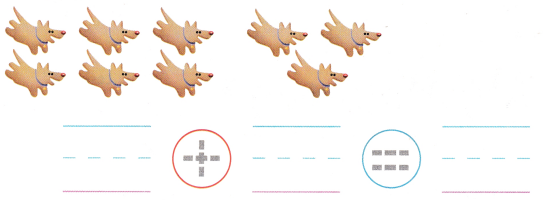
Answer: 6 + 3 = 9
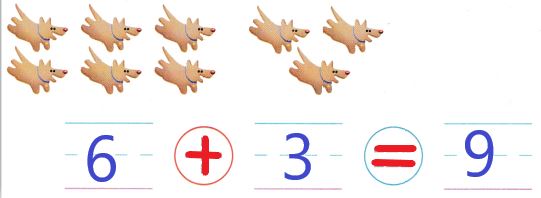
Number of objects in first group = 6
Number of objects in second group = 3
Therefore, total number of objects =6 + 3 = 9
The + in general called as addition symbol. This addition symbol is usually used to indicate that two or more numbers should be added together.
Combining things and counting them as one big group is done through addition. In math, addition is the process of adding two or more integers together. Addends are the numbers that are added, and the result or the final answer we get after the process is called the sum.
The = equals symbol is used to show that the values on either side of it are the same. It is most commonly used to show the result of a calculation.
Question 5.
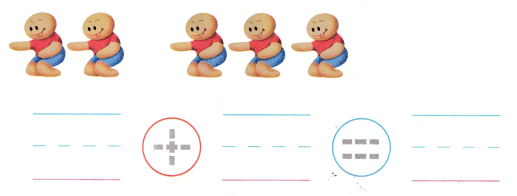
Answer: 2 + 3 = 5

Number of objects in first group = 2
Number of objects in second group = 3
Therefore, total number of objects =2 + 3 = 5
The + in general called as addition symbol. This addition symbol is usually used to indicate that two or more numbers should be added together.
Combining things and counting them as one big group is done through addition. In math, addition is the process of adding two or more integers together. Addends are the numbers that are added, and the result or the final answer we get after the process is called the sum.
The = equals symbol is used to show that the values on either side of it are the same. It is most commonly used to show the result of a calculation.
Question 6.
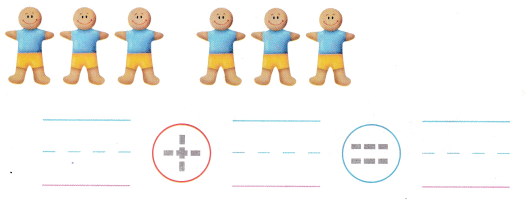
Answer: 3 + 3 = 6
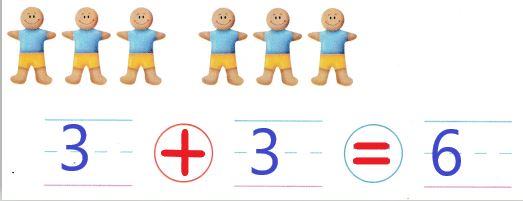
Number of objects in first group = 3
Number of objects in second group = 3
Therefore, total number of objects =3 + 3 = 6
The + in general called as addition symbol. This addition symbol is usually used to indicate that two or more numbers should be added together.
Combining things and counting them as one big group is done through addition. In math, addition is the process of adding two or more integers together. Addends are the numbers that are added, and the result or the final answer we get after the process is called the sum.
The = equals symbol is used to show that the values on either side of it are the same. It is most commonly used to show the result of a calculation.
Directions: 4-6. Count the objects in each group. Write the numbers and trace the symbols. Write how many there are in all.
Math at Home Have your child make a group of three items and a group of four items. Tell your child to join the groups and tell how many there are in all.
Answer: 3 + 4 = 7
Number of objects in first group = 3
Number of objects in second group = 4
Therefore, total number of objects =3 + 4 = 7
The + in general called as addition symbol. This addition symbol is usually used to indicate that two or more numbers should be added together.
Combining things and counting them as one big group is done through addition. In math, addition is the process of adding two or more integers together. Addends are the numbers that are added, and the result or the final answer we get after the process is called the sum.
The = equals symbol is used to show that the values on either side of it are the same. It is most commonly used to show the result of a calculation.